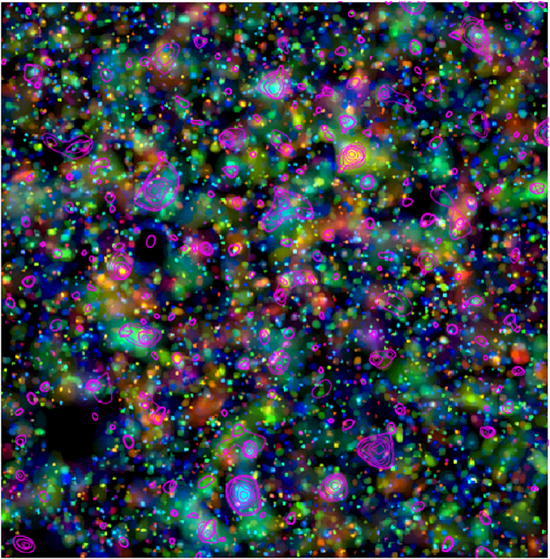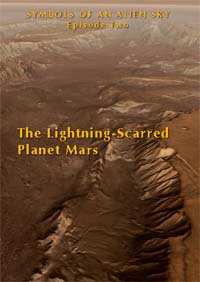|

Supposed galaxy density in the
Cosmic Evolution Survey. Redshift of
0.2 (blue) to 1 (red).
X-ray emission contours in pink.
Credit: ESA
Doubting the Dark
Feb
18, 2011
Dark matter theory's claims have not convinced everyone in consensus circles.
Another in a series of
announcements from NASA and the European Space Agency
reports "the confirmation" of dark
matter. Dark matter, as its name
implies, is non-luminous, invisible
to telescopes, and weakly
interacting (at best) with the
"baryonic" matter around it.
However, its existence has been
considered an essential aspect of
cosmology because, as an
ESA scientist
put it a few years ago: "Our own
galaxy should have fallen apart by
now, so dark matter—this unseen
force—is somewhere keeping it glued
together."
After studying the
Coma Cluster of galaxies in 1933,
Fritz Zwicky found that
his calculations for orbital
acceleration and stellar mass within
it were off by a factor of about
160. He thought that something
invisible to his instruments was
holding the cluster together. That
"something" later became known as
"dark matter." His hypothesis was
supposedly confirmed in 1979 with
the announcement of "gravitational
lensing" (another theory of Zwicky's)
and the "twin quasar"
QSO0957+561 A, which are
not topics of this paper.
It should be noted that some
astrophysicists are not convinced
that dark matter or its enigmatic
twin "dark energy" are justified
because the data used to support
their existence is questionable.
Observations from both COBE and WMAP
might have calibration issues that
"...could indicate that fluctuations
measured in the intensity of the CMB
radiation are actually smaller than
they originally appeared. The size
of these fluctuations is a key
parameter used to support the
existence of dark matter and dark
energy. With smaller ripples, there
would be no need to invoke exotic
concepts like dark matter and dark
energy to explain the CMB
observations."
Since dark matter cannot be seen
by optical telescopes and can be
analyzed through inference alone,
could it be that something else is
taking place? Something that NASA
and the ESA observers have failed to
consider as an active force? That
"something" is electricity.
Electric Universe theorists see
electricity flowing through plasma
driving galaxy clusters, galaxies
themselves and their associated
stars.
Birkeland currents create
z-pinch compression
zones between spinning
magnetic fields in electrical
vortices. The compressed ions form
spheres of glowing plasma, some in
arc mode, some in glow mode, and
some that vary between the two
states.
Electric currents pouring into
them from the outside power the
stars and galactic wheels. What
should we expect to see in their
shapes and behavior in that case?
1. Around the galaxies and
throughout the cluster will be
Birkeland current filaments slowly
fluctuating in their intensity,
causing mass density variations that
will be difficult to interpret
(without the “blank check” of dark
matter) as gravitational effects.
2. The plasma in which the
galaxies exist contains magnetic
fields that map the Birkeland
current flows, interconnecting each
galaxy with its neighbor and forming
electrical bridges between them.
3. Electrical charges separate
from one another across a double
layer in a Birkeland current
filament. Double layers may break
down if too much current flows in
the circuit. In that instance, there
will be a stellar flare, a gamma-ray
flash, a nova or a supernova.
Since Birkeland currents are
drawn toward each other in a linear
relationship, dark matter is
unnecessary when electric currents
flowing through plasma are
recognized as the most powerful
long-range accretion force.
Stephen Smith
Multimedia

The Lightning-Scarred Planet Mars
Symbols of an Alien Sky
DVD episode 2
A video documentary that could change everything you thought you knew
about ancient times and symbols.
The Symbols of an Alien Sky video series will introduce you to celestial
spectacles and earth-shaking events once remembered around the world.
Archaic symbols of these events still surround us, some as icons of the
world’s great religions, though the origins of the symbols appear to be
lost in
obscurity.
In this second episode of Symbols of an Alien Sky, David
Talbott takes the viewer on an odyssey across the surface of Mars.
Exploring feature after feature of the planet, he finds that only
electric arcs could produce the observed patterns. The high resolution
images reveal massive channels and gouges, great mounds, and crater
chains, none finding an explanation in traditional geology, but all
matching the scars from electric discharge experiments in the
laboratory.
(Approximately 85 minutes) See:
Lightning-Scarred
Planet info
|








